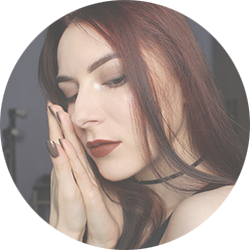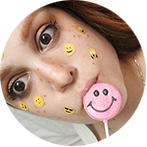







Welcome Back
Sign in to be closer to your community!
Follow other divas, like and comment
on their posts, message them, and see
who loved your posts!
Invalid username or password
You have not verified your account by clicking on the link we sent you via email. Please check your email folders (including your Spam folder) and click on the verify link sent.
Email is required
Password is required








Join FashionPotluck.com
Create your own profile in order to create content, follow other divas and like their posts, use our own messenger, and be a part of a growing international women community!
WELCOME TO OUR COMMUNITY
Fashion Potluck -
the first social media
platform for women.
You are free to read/watch & create content,
express your true self, and interact with others.
Join for free
Already a member? Log in here.
Purchase Alert
Dear Queen, you can only buy from one seller at the time. Please finish this purchase first in order to buy from another FP member
Comments
Please select one platform to continue
Please select one platform to continue
Please select one platform to continue
Please select one platform to continue
Please select one platform to continue
Please select one platform to continue
Please select one platform to continue
Please select one platform to continue
EDITOR APPROVED
You are wondering what is this 'Editor Approved'?
Well, this is pretty awesome! In order for the post to qualify and receive this accolade, it has to have a minimum of 700 words and two images (at least one original).
Receiving this accolade means two things: 1) Your content is amazing! Good job! 2) Your content qualifies for our monetization program. Every week two of the most read posts receive monetary rewards.
Have the badge & want to monetize your content?

LOOKS


Exfoliation has definitely been one of the hottest topics in recent years in the beauty industry and I can’t help but wonder- how to exfoliate to get the best results? Brands selling exfoliators have enthusiastically been trying to sell me the idea that exfoliators are great for the skin and that I should use them as often as possible, however, be aware- the truth, indeed, might be a bit different. Let’s check the other side of the story!

What does an exfoliator do?
Exfoliators remove the first layer of your skin and this also means the bacteria which were situated there are gone. The process indeed gives your skin an instant shine, however, the latter is not as long-lasting as most of us would wish it to be.
Even though the first layer of dust is indeed removed through exfoliation, the process also exposes raw skin, which, naturally, is more prone to irritations and sun damage.
I know how difficult it can be not to over-exfoliate as we all love the glowy, after-treatment look. When it comes to exfoliation, I always stick to the same rule: ‘ No matter how great your skin looks, don’t over-exfoliate it, as you will probably regret it the day after’.
How often should you exfoliate?
Keep in mind, there is no ‘magic number’ of times you have to exfoliate and with so many different advice, you for sure get completely lost at one point. Therefore, just consult this table as the frequency of exfoliating definitely differs per skin type!
Type of Skin | Exfoliation frequency | |
Dry skin | 2 times per week | |
Oily/Combination Skin | 3-4 times per week | |
Normal skin | 1 time per week |
How to choose which exfoliator to use?
If you are not very familiar with exfoliation, you should at least know about these two basic features:
1) Mechanical exfoliation
2) Chemical exfoliation
Mechanical exfoliation involves a process where skin cells are removed by a physical friction using a device like a loofah, while chemical exfoliation involves using substances which biologically ‘loosen the glue between the skin’s outer layer cells to allow the outer cells to shed’. Both methods have their advantages and disadvantages, and it also really depends on the area of your body you want to exfoliate. Chemical exfoliation might reach deeper layers, while mechanical is more natural. I would encourage trying out both methods and seeing what best works for you- just don’t do it too often, as you will irritate your skin.
Mechanical exfoliation explained
Mechanical exfoliation basically means using a rough texture and through friction, removing old dead cells from your skin. If you use this method, keep in mind that you can’t rely only on a loofah to remove the layer of skin, but that you should use a serum as well to loosen the cells. If you have acne and already are using chemical treatments, I would recommend sticking to this method.
Chemical exfoliation explained
If you opt for a chemical exfoliation, you will probably come across two types of substances - ‘AHA’ and ‘BHA’. When I see this, I really start wondering if beauty companies confused us with chemistry students? … Anyways, let me proceed with the explanations, as it seems no one else will.
Both AHA (or alpha hydroxy acids) and BHA ( or beta hydroxy acid) are chemicals which exfoliate your skin by dissolving the glue which holds skin cells together, with one main difference: AHA is water-soluble, while BHA is oil-soluble. This means the following:
If you have dry skin, use products which contain AHA, as these offer hydration and are collagen-boosting. Side effects include possible skin irritation, so make sure to apply this type of exfoliator in smaller amounts and not so frequently.
If you have sensitive skin, then stick to the lactic acid as it is the gentlest one and will exfoliate your skin without irritating it.
If you have oily skin, look for products with BHA, as it contains properties which are great for that skin type. BHA penetrates the pores and unclogs them from within and can also soothe irritation and redness due to its anti-inflammatory properties. This means it is also suitable for acne-prone skin types.
My favorite exfoliator products
I have experimented a lot with exfoliation, and although I rather go for mechanical one, here are my top 3 favorite products for both methods.
AHA 30% + BHA 2% Peeling Solution - 9$
As you can see, this is a chemical exfoliator and this product was already discussed about on the Fashion Potluck Blog. You can purchase it for $9 on Sephora.
Sunday Riley Good Genes All-In-One Lactic Acid Treatment - $79

If you are wiling spending more money on exfoliation, I would recommend purchasing this product. It is great for sensitive skin as it based on lactic acid, which does not irritate your skin. However, be aware that the lactic acid also gives the product a yeasty smell! You can purchase it at Dermstore for $79.
Instrumental Beauty Sonic Touch Cleansing System - $35
This product is used for mechanical exfoliation and with its sonic brush, it provides a good treatment without irritating your skin. I usually combine It with a gentle cream cleanser. I would recommend purchasing this product as you can use it for years! You can purchase it on Amazon for $35.
And we have come to an end! I hope by now you are more familiar with exfoliation and methods of using exfoliators in a proper way! I would love to hear your beauty routines and methods of keeping your skin beautiful!
PS. If you are interested in a full beauty routine, check this post!
xxx
Una
Comments
Related Posts
- Affordable Embroidery Services | Free Design Assistance by Embroidery Designs 0
- Why Cowboy Ties Are Making a Bold Fashion Comeback This Year by Rocky Mountain Western 0
- Havva Fashion – Trendy Women’s Wear for Every Occasion by 0
More Posts
- What Makes Men’s Accessories Worth Investing In Today? by Ekim Fashion 0
- How to Plan Seasonal Plush Inventory Without Overbuying by Harnel Inc 0
- 6 Winter Season Reasons to See a Dermatologist ASAP by Monica Quinn 0
Vote content out
Reason for voting this content out?
Reason for voting this content out?


 Login with Google
Login with Google Login with Twitter
Login with Twitter






 by
by 

Add Comments